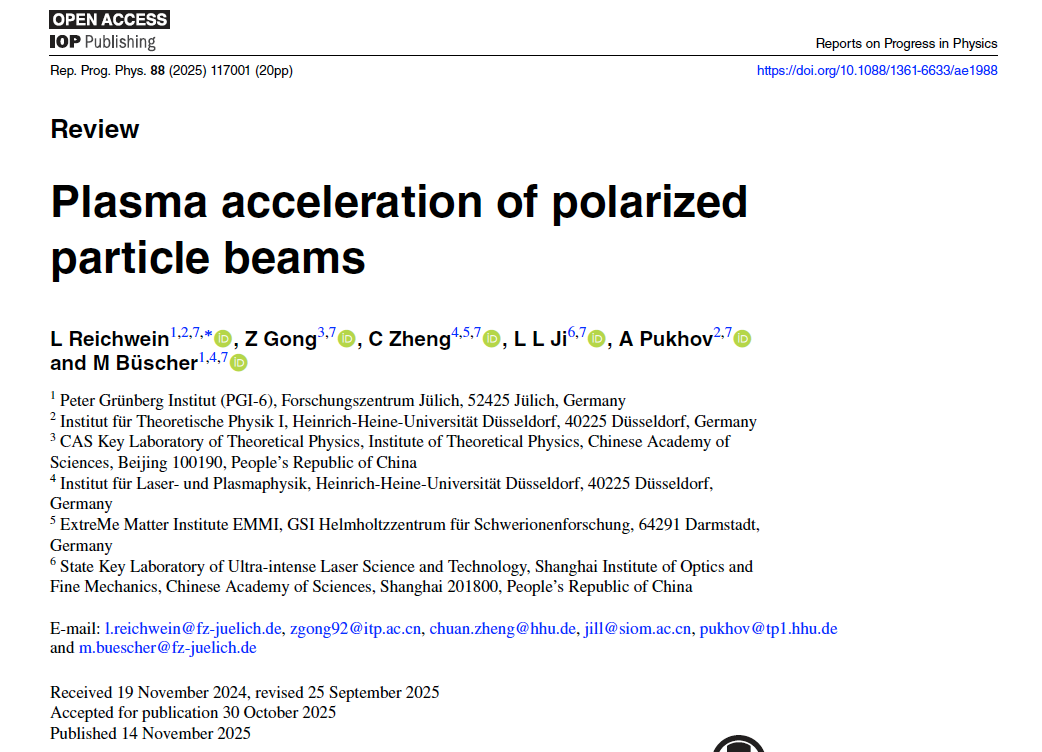Research Progress
Plasma Acceleration of Polarized Particle Beams
A new review article titled “Plasma acceleration of polarized particle beams” has been published in Reports on Progress in Physics, providing the first comprehensive survey of this emerging research area. The review offers a systematic synthesis of the physical foundations, experimental developments, and conceptual acceleration schemes that underpin the rapidly growing field of plasma-based acceleration of polarized particle beams. It also outlines a prospective roadmap for the field as it advances toward experimental realization and practical applications.
The authors highlight that integrating spin polarization with ultrahigh-gradient plasma acceleration represents a promising pathway toward next-generation particle-beam technologies. Such beams could play a transformative role in high-energy physics, nuclear physics, and fusion research. At the same time, the extreme, rapidly evolving electromagnetic fields inherent in laser–plasma environments pose significant challenges for maintaining particle polarization during acceleration. To address this, the review presents a unified discussion of the three principal mechanisms governing spin evolution in plasma accelerators: spin precession, spin-dependent beam dynamics, and radiative spin polarization. Among these, the Thomas–Bargmann–Michel–Telegdi (T-BMT) spin-precession effect is identified as the dominant source of depolarization across most current laser–plasma accelerator configurations. The article further quantifies the relevant depolarization timescales, providing essential theoretical constraints for the design of future polarization-preserving experiments.
The review examines two key technological pathways for generating polarized plasmas: pre-polarized targets and in-situ polarization methods. Demonstrations using pre-polarized 3He gas targets have verified that spin polarization can survive laser-driven acceleration. Meanwhile, emerging in-situ schemes, such as laser-induced polarization of hydrogen or selective ionization of atoms like xenon or ytterbium, offer routes to higher-density plasmas without external magnetic holding fields, marking them as particularly promising for future development.
For various particle species, the review summarizes recent conceptual and numerical progress:
· Polarized Electrons: Laser wakefield acceleration combined with advanced injection concepts, including Laguerre–Gaussian modes and colliding pulse injection, has enabled simulations of high-quality electron beams with polarization exceeding 80%. A key conclusion is that depolarization is concentrated in the injection stage, with minimal degradation during subsequent acceleration.
· Polarized Positrons: Given the difficulty of direct positron polarization, current research focuses on producing polarized positrons via intermediate processes such as the nonlinear Breit–Wheeler mechanism. Several theoretical models predict achievable positron polarization on the order of 60%, using polarized electrons or polarized gamma photons as drivers.
· Polarized Ions: Magnetic vortex acceleration and collisionless shock acceleration have emerged as two leading candidates for ion polarization. The former is well suited for generating high-charge-state beams, while the latter offers favorable conditions for maintaining very high polarization.
· Polarized Gamma Photons: Produced through nonlinear Compton scattering, polarized gamma photons constitute a mature radiation source. The review notes their potential as a passive diagnostic tool: gamma-ray polarization encodes information about the transient electromagnetic fields and ultrafast plasma dynamics inside laser-driven targets.
While theoretical modeling and simulations have progressed rapidly, the authors emphasize that experimental validation remains the most urgent objective. In particular, demonstrating the production, injection, and acceleration of polarized electrons and positrons in laser–plasma environments is a critical next step. The development of advanced polarimetry capable of resolving femtosecond-scale, high-current plasma-accelerated beams will be indispensable for these efforts.
Looking to the future, the review outlines a broad range of scientific opportunities enabled by plasma-accelerated polarized beams. These include applications as injectors for next-generation high-luminosity colliders and free-electron lasers, as tools for polarized-fuel fusion studies, and as probes for time-resolved nuclear physics experiments. With major laser facilities such as ELI (Extreme Light Infrastructure) and SULF (Shanghai Superintense Ultrafast Laser Facility) becoming operational, the field is poised to transition from conceptual development toward systematic experimental optimization and, ultimately, application-driven research.
The review was authored by Lars Reichwein (Forschungszentrum Jülich, Germany), Zheng Gong (Institute of Theoretical Physics, Chinese Academy of Sciences), Chuan Zheng (Heinrich Heine University Düsseldorf), Liangliang Ji (Shanghai Institute of Optics and Fine Mechanics, CAS), Alexander Pukhov (Heinrich Heine University Düsseldorf), and Markus Büscher (Forschungszentrum Jülich). The article was published online on November 14.
Full article: https://doi.org/10.1088/1361-6633/ae1988

